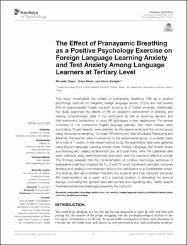The effect of pranayamic breathing as a positive psychology exercise on foreign language learning anxiety and test anxiety among language learners at tertiary level
Künye
Taşan, M., Mede, E. ve Sadeghi, K. (2021). The effect of pranayamic breathing as a positive psychology exercise on foreign language learning anxiety and test anxiety among language learners at tertiary level. Frontiers in Psychology, 12. https://dx.doi.org/10.3389/fpsyg.2021.742060Özet
This study investigated the impact of pranayamic breathing (PB) as a positive psychology exercise on mitigating foreign language anxiety (FLLA) and test anxiety (TA) of undergraduate English students studying at a Turkish university. Additionally, the study examined the effects of PB on academic achievement in listening and reading comprehension skills of the participants as well as exploring learners' and their instructor's perceptions of using PB techniques in their classrooms. The sample consisted of 140 sophomore English language learners. Two intact classes, each comprising 70 participants, were selected as the experimental and the control group using convenience sampling. Two basic PB techniques, Nadi Shodhana Pranayama and Bhramari Pranayama, were implemented to the experimental group on a weekly basis for a total of 7 weeks. In this mixed-method study, the quantitative data were gathered using English Language Learning Anxiety Scale, Foreign Language Test Anxiety Scale, and listening and reading achievement pre- and post-tests, while the qualitative data were collected using semi-structured interviews, and the teacher's reflective journal. The findings revealed that the implementation of positive psychology technique of pranayama breathing mitigated the FLLA and TA levels significantly and also improved listening and reading comprehension skills of the participants to a considerable extent. The findings also demonstrated that both the students and their instructor perceived PB implementation as a useful and a practical medium in alleviating the anxious feelings, promoting the general class atmosphere and regulating daily habits despite the implementational challenges shared by the instructor.


















